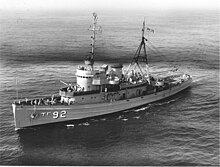The United States Navy, United States Coast Guard, and United States National Oceanic and Atmospheric Administration (NOAA) use a hull classification symbol to identify their ships by type and by individual ship within a type. The system is analogous to the pennant number system that the Royal Navy and other European and Commonwealth navies use.

USS Zuni (AT/ATF-95), a Cherokee-class fleet tugboat, formerly called Navajo class, was a ship of the United States Navy named for the Zuni, the popular name given to a tribe of Pueblo Indians indigenous to the area around the Zuni River in central New Mexico near the Arizona state line.
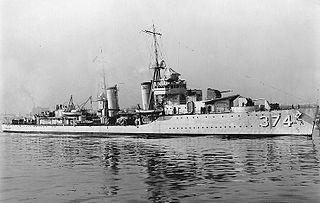
USS Tucker (DD-374) was one of 18 Mahan-class destroyers built for the United States Navy and was commissioned in 1936. Tucker's main battery consisted of five dual-purpose 38 caliber 5-inch guns.
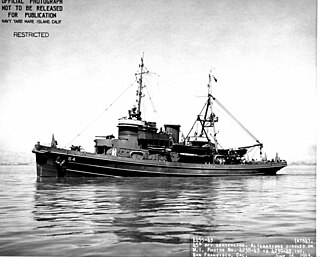
USS Navajo (AT-64) was an oceangoing tugboat in the United States Navy, and the lead ship of its class. It was named for the Navajo people. Originally called the Navajo-class of fleet tugs, it was later renamed the Cherokee-class after loss of the first two ships of the class.

A Service Squadron (ServRon) was a United States Navy squadron that supported fleet combat ships and US Navy Auxiliary ships. Service Squadrons were used by the US Navy from their inception in 1943 to as late as the early 1980s. At the time of their inception during the Second World War they allowed the US Navy to operate across the vast reaches of the Pacific Ocean for extended periods of time. Service Squadrons created temporary forward bases to allow the naval squadrons to spend less time in transit and more time in the area of combat. Ulithi, a small volcanic atoll in the central Pacific, is an example of a site converted for use as a forward base of supply. Service Squadrons essentially created a major naval base near the area of operation. With naval bases like, Naval Base Ulithi, to refit, repair and resupply, many ships were able to deploy and operate in the western Pacific for a year or more without returning to a major port facility. Among the vessels operating in service squadrons were tankers, Fleet oilers, refrigerator ships, ammunition ships, supply ships, floating docks and repair ships. They provided diesel, ordnance, aviation fuel, food stuffs and all other supplies. Equally important at places like Ulithi were the portable piers and floating dry docks which allowed many ships damaged by enemy action or Pacific storms to undergo repair without having to travel the thousands of miles back to a major US naval base. Ulithi was as far forward from the US naval base at San Francisco as the San Francisco base was from London, England. To have a fully functional major port in the middle of the Pacific was a significant aid to U.S. Navy operations.

USS Yuma (AT-94/ATF-94/T-ATF-94) was a Navajo-class fleet tugboat constructed for the United States Navy during World War II. She was the second U.S. Navy ship named for the Yuma tribe of Arizona.

USS Seminole (AT-65), the third ship named Seminole of the United States Navy, was a Navajo-class fleet tug whose task was to travel with the fleet and provide towing services as required.
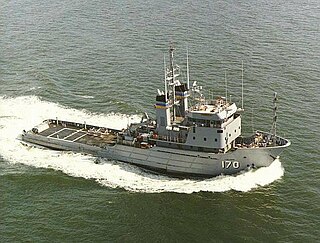
USNS Mohawk (T-ATF-170) was a United States Navy Powhatan-class tugboat operated by the Military Sealift Command from 1980 to 2005.

A net laying ship, also known as a net layer, net tender, gate ship or boom defence vessel was a type of naval auxiliary ship.

Arapaho-class tugboats were oceangoing tugboats designated fleet tugs by the United States Navy during their service in the early half of the 20th century. They were in service during World War I and World War II. Arapaho was built by the Seattle Construction and Drydock Company in Seattle, Washington.

Luna is a historic tugboat normally berthed in Boston Harbor, Massachusetts. Luna was designed in 1930 by John G. Alden and built by M.M. Davis and Bethlehem Steel. She is listed on the National Register of Historic Places and is a U.S. National Historic Landmark. In 1985, the Luna was designated as a Boston Landmark by the Boston Landmarks Commission.

USS Nokomis (YT-142/YTB-142/YTM-142) was a Woban-class harbor tug built in Bremerton, Wash, and assigned to Pearl Harbor, Hawaii, in 1940. Nokomis was present during the Japanese attack on Pearl Harbor, 7 December 1941. She was the first vessel on scene at the USS Arizona, and was called off by the officers on deck because of the imminent explosion of the battery below deck. It then left and helped beach the USS Nevada, with Hoga (YT-146), and YT-153. The beaching of the Nevada saved Pearl Harbor's mouth from being blocked. After that the USS Nokomis fought fires and dewatered the battleship USS California, for 3 days. This effort made the California salvageable, to be recommissioned again later in the war. Nokomis was also the last vessel to move the surviving YC-699 barge prior to the Japanese attack on Pearl Harbor. Post-war she continued serving Pearl Harbor ships until she was decommissioned in May 1973, and eventually sold for "scrap" to Crowley, in San Francisco. She was renamed Sea Serpent and served many years in the San Francisco Bay as a tug and fire boat. In 1989, after the Loma Prieta earthquake in the SF Bay area, Nokomis and Hoga fought fires alongside each other again.
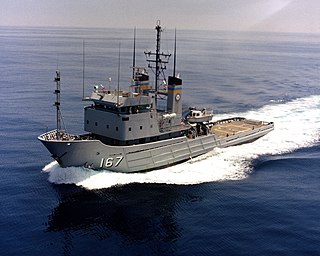
USNS Narragansett (T-ATF-167) is a Powhatan-class fleet ocean tugboat of the US Navy. She was launched in 1979 and inactivated in 1999, but has since been employed in a number of roles. She is still in service as of 2023 as a training support vessel for Carrier Strike Group 4.

USNS Navajo (T-ATF-169) was a United States Navy Powhatan-class tugboat operated by the Military Sealift Command which was in service from 1980 to 2016. She spent the bulk of her career in the Pacific and is currently moored in Pearl Harbor, awaiting disposal.

USNS Sioux (T-ATF-171) was a United States Navy Powhatan-class tugboat operated by the Military Sealift Command (MSC). She was in service from 1981 to 2021 and spent the bulk of this time supporting the Pacific Fleet.

The Powhatan class of fleet ocean tugs consists of seven ships built for the United States Navy, and operated by the Military Sealift Command (MSC). The lead ship of the class was launched in 1978 and the last ship in MSC service will be deactivated in 2023. During their service life, the Powhatan's were the most powerful tugs owned by the Navy.
USS Cherokee (AT-66) was a US Navy fleet tug of the Navajo class, later renamed the Cherokee class. She was launched on 10 November 1939 by Bethlehem Shipbuilding Corp., Staten Island, New York and sponsored by Miss E. Mark; and commissioned 26 April 1940. Cherokee served during World War II in the North African campaign. She was redesignated ATF-66 on 15 May 1944.

The Type V ship is a United States Maritime Commission (MARCOM) designation for World War II tugboats. Type V was used in World War II, Korean War, and the Vietnam War. Type V ships were used to move ships and barges. Type V tugboats were made of either steel or wood hulls. There were four types of tugboats ordered for World War II. The largest type V design was the sea worthy 186-foot (57 m) long steel hull, V4-M-A1. The V4-M-A1 design was used by a number of manufacturers; a total of 49 were built. A smaller steel hull tugboat was the 94-foot (29 m) V2-ME-A1; 26 were built. The largest wooden hull was the 148-foot (45 m) V3-S-AH2, of which 14 were built. The smaller wooden hull was the 58-foot (18 m) V2-M-AL1, which 35 were built. Most V2-M-AL1 tugboats were sent to the United Kingdom for the war efforts under the lend-lease act. The Type V tugs served across the globe during World War II including: Pacific War, European theatre, and in the United States. SS Farallon, and other Type V tugs, were used to help built Normandy ports, including Mulberry harbour, on D-Day, 6 June 1944, and made nine round trips to Normandy to deliver Phoenix breakwaters.
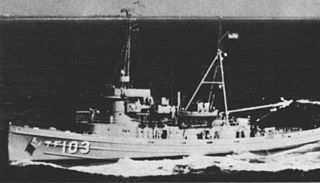
USS Hitchiti (ATF-103) was Abnaki-class tugboat during the World War II, Korea and Vietnam. The ship was later sold to Mexico as ARM Chac (R-55). Her namesake is a tribe of Creek Indians who lived in Florida and Georgia. The word "Hitchiti" means "to look up the stream."

Bethlehem Staten Island also called Bethlehem Mariners Harbor was a large shipyard in Mariners Harbor, Staten Island, New York. The shipyard started building ships for World War II in January 1941 under the Emergency Shipbuilding Program and as the result of the Two-Ocean Navy Act of July 1940. The shipyard was part of the Bethlehem Shipbuilding Corporation which built ships for the United States Navy, and the United States Maritime Commission. Bethlehem Steel purchased the shipyard in June 1938 from United Shipyards. Bethlehem Shipbuilding Corporation closed the shipyard in 1959. The propeller factory and foundry continued operation for 10 more years at the site. Since 1980 the site is the May Ship Repair Contracting Corporation next to Shooters Island at the southern end of Newark Bay, off the North Shore.

